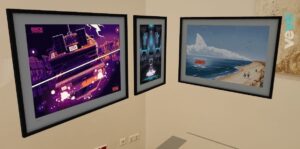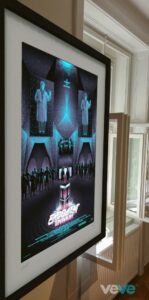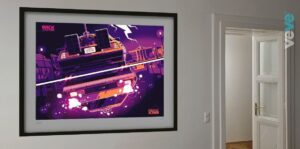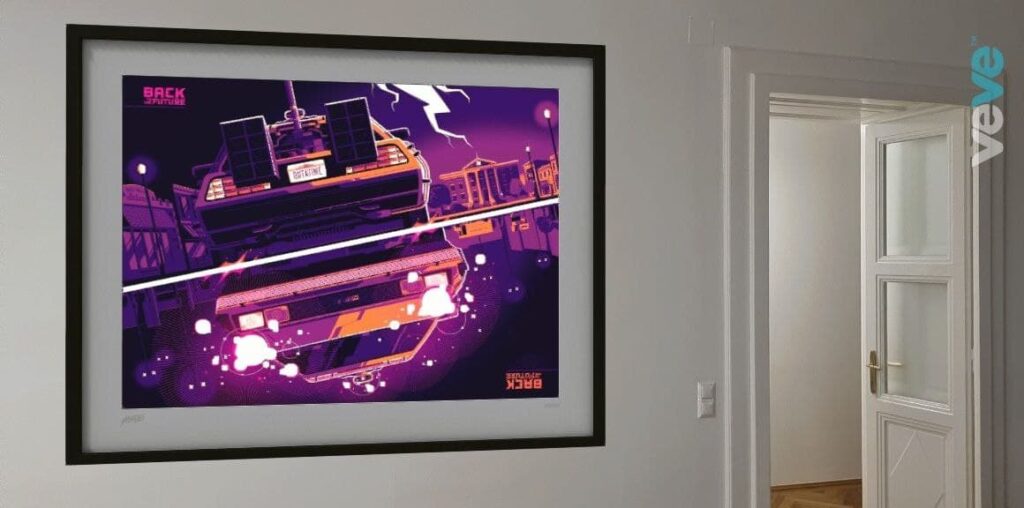Mit dem Aufkommen neuer Technologien wie AR und VR, oder vielleicht genauer ausgedrückt, den sinkenden Kosten solcher Technologien und ihrer stetigen Einführung in den Mainstream und den täglichen Gebrauch, können viele andere Zweige, die zuvor völlig unabhängig schienen, gestärkt werden. Sei es, dass diese in einem neuen frischen Stil wieder ins Rampenlicht gerückt, neu belebt und entstaubt werden, um wieder zu glänzen, oder sogar so weit aufgewertet werden, dass sie die neuere technisch versierte Generation von Verbrauchern ansprechen und vielleicht darüber hinaus Möglichkeiten nutze, welche bisher ungeahnt, unerhört und unvorstellbar waren.
Ein brillantes Beispiel für solche Anwendungsfälle ist die App Artivive, welche bereits die Kluft zwischen der physischen und der digitalen Welt überbrückt hat, beide gegenseitig verbessert und eine neue Erfahrung kreiert, wie wir Kunst im Allgemeinen betrachten, Ausstellungen genießen und sogar es schafft, Menschen anzuziehen, die sich bisher für Kunst nicht interessiert haben. Es bringt buchstäblich neues Leben in die Kunst durch den Einsatz von Augmented Reality.
Mit dieser neuen Art, Inhalte zu visualisieren und in eine andere Art von Realität einzutauchen, die wir nun einerseits ohne viele der Einschränkungen unserer Kreativität durch die physischen Welt gestalten können, und darüber hinaus die leichtere Zugänglichkeit und Verfügbarkeit aus Ressourcensicht , können ganz neue Welten geschaffen werden, was bis zu einem gewissen Grad bereits getan wird.
Mit zunehmender Benutzerfreundlichkeit, Zugänglichkeit und Kosteneffizienz werden die Hürden für die Akzeptanz weiter schrumpfen und die Kreativität gedeihen lassen. Seien es Ausstellungen in erweiterten Formaten wie bei Artivive, ob virtuelle Konzerte wie das Neujahrskonzert von Jean-Michel Jarre in Notre Dame, immersiver Geschichtsunterricht im Klassenzimmer und vieles mehr. Ob historisch akkurat oder ganz fantasievoll, wie immer ist die einzige Grenze unsere Fantasie.
Andere Projekte an der Schwelle zur neuen digitalen Technologie Blockchain gehen noch einen Schritt weiter.
Blockchain als solches ist in jeder Hinsicht ein relativ unerforschtes Terrain. Von Vorschriften bis hin zu tatsächlichen Anwendungsfällen ist die Zukunft dieser neuen Technologie und ihrer verschiedenen Vorteile stark umstritten.

Nicht weniger umstritten, aber umso neuer, ist eine Nische oder Unterkategorie, bei denen es sich um non fungible tokens (nicht frei austauschbare Tokens) oder NFTs handelt. Ohne ins Detail zu gehen, können wir normales FIAT-Geld, das wir täglich verwenden, und beispielsweise einen Krügerrand, eine bekannte Sammlermünze, vergleichen. Wenn wir mit FIAT-Geld interagieren, sind Ihr 100 € Schein für Sie genauso grün wie der meinige, und ob Sie meinen Geldschein haben oder umgekehrt, spielt für beide Seiten keine Rolle. Wir können die 100 € auch in kleinere Stückelungen aufteilen. Im Gegensatz zum vorherigen Beispiel würde niemand einen Krügerrand verwenden, um seine Lebensmittel zu bezahlen, wenn Sie versuchen ihn in kleinere Teile zu zerbrechen, wird er beschädigt und entwertet, und selbst wenn wir beide je einen Krügerrand hätten, könnten Sie eine niedrigere / seltenere Prägung haben oder deines könnte in einem besseren Zustand sein und somit wertvoller sein, und du hättest kein Interesse daran, deins mit meinem zu tauschen, weil beide einzigartig sind und du das bessere hast. Im Gegensatz zu Bitcoin, das frei austauschbar, fungibel und teilbar ist, sind NFTs also Tokens, mit denen wir das Eigentum an einzigartigen Gegenständen auf digitale und unveränderliche Weise darstellen können.
Im Video sind zum Beispiel Poster von Mondo zu sehen. Sie veröffentlichen normalerweise alternative Siebdruckplakate in limitierter Auflage von populären Popkultur-IPs wie Filmen, Fernsehsendungen usw.. Das sind in der Tat auch NFTs. Sie haben jeweils eine einzigartige Seriennummer und eine begrenzte Menge von etwa 2000 Stück. Diese haben einen Wert, weil sie nicht nur eindeutig identifizierbar und selten sind, sondern weil mein Besitz als NFT unbestritten auf der Blockchain vermerkt ist und keine weiteren Kopien geprägt werden.
Die Implikationen dieser Nischentechnologie werden in den kommenden Jahren einen großen Teil der digitalen Revolution ausmachen, da der Besitz digitaler Vermögenswerte nicht nur möglich und salonfähiger wird, sondern auch eine eigene Wirtschaft daraus entstehen wird. Die heutigen Kinder, die als Digital Natives aufwachsen, sind bereits daran gewöhnt, dass etwas nicht unbedingt greifbar sein muss, um einen Wert zu haben. Stellen Sie sich andererseits vor, dass selbst ernsthafte Schätzungen darüber, wie viel der Geldmenge der Welt rein digital ist, zwischen 80 und 92 % liegen, also warum ist das so viel anders? Unsere kollektive Akzeptanz und die Bereitschaft, damit Geschäfte zu machen, ist fast alles, was dem einen Wert gibt. Wenn wir Wahnsinn und übertriebene Absurdität ausschließen, braucht es nur eine Person, die bereit ist, dafür zu bezahlen, damit etwas wertvoll ist.

With the advent of new technologies such as AR and VR, or perhaps more accurately expressed, the decreasing cost of such technologies and their steady adoption into mainstream and everyday use, many other branches which before seemed utterly unrelated, can be empowered. Be it that these are brought back to the limelight in a new fresh style, reinvigorated and dusted off to shine once more, or even enhanced to the point where it appeals to the newer tech-savvier generation of consumers and perhaps beyond that to explore possibilities previously unimagined, unheard and unthought of.
Once brilliant example for such use-cases is the app Artivive, which has already bridged the crevice between the physical and digital world, enhancing one with the other, and creating a new experience at how we look at art in general, enjoy exhibitions and even manages to draw in people previously uninterested in art. It literally brings new life to art with the use of augmented reality.
With this new way to visualise and immerse ourselves into a different kind of reality which we can now shape on the one hand without many of the limitations to our creativity of the physical world, and furthermore the easier accessibility and availability from a resource point of view, entirely new worlds can be created, which to a certain degree is already being done.
As the ease of use, accessibility and cost-efficiency increase, the barriers of adoption will further shrink and dwindle, allowing creativity to thrive. Be it exhibitions in enhanced formats as with Artivive, be it virtual concerts like the new year’s concert by Jean-Michel Jarre in Notre Dame, immersive history lessons in classrooms and many more. Be it historically accurate or entirely imaginative, as per usual only our creativity is the limit.

Other projects on the cusp of the new digital technology which is blockchain go even a step further.
Blockchain as such is already a relatively unexplored territory, in every sense. From regulations to actual use cases, the future of this new technology and its various assets is highly disputed.
No less debated, but all the newer, is a niche or sub-category if you will, which are non-fungible tokens or NFTs. Without going into detail, we can compare regular FIAT money which we use every day and for example a Krugerrand, which is a well-known collectors coin. When we interact with FIAT money, your 100 € are as green to you as they are to me, and whether you have my bill or vice versa, it really doesn’t matter to either party. We can also split the 100 € into smaller denominations. Contrary to the previous example, no one would use a Krugerrand to pay for their groceries, if you try to break into smaller parts, it becomes damaged and devalues, and even if we both had one Krugerrand each, you might hold a lower mint or yours might be in better condition, thus being more valuable and you would have no interest of changing yours with mine, because both are unique, and you have the better one. So, in contrast to Bitcoin, which is freely interchangeable fungible and divisible, NFTs are tokens that we can use to represent ownership of unique items in a digital and immutable way.
In the video for example you can see posters by Mondo. They release alternative limited-edition screen-printed posters of popular pop culture Ip’s like movies, tv-shows etc. Those are in fact also NFTs. They each have unique serial number and a limited supply of roughly 2000 pieces. These hold value because they are not just uniquely identifiable and scarce, but because by it being an NFT my ownership of it is undisputedly recorded on the blockchain and no further copies will be minted.
The implications of this niche technology alone will be a great part of the digital revolution in the coming years as ownership of digital assets not just becomes a possibility but creates its own economy. Today’s children who grow up as digital natives are already accustomed to the idea, that for something to hold value, it doesn’t necessarily have to be tangible. Then again, imagine that even serious estimates of how much of the world’s money supply is pure digital, range from 80% to 92%, so why is that any different. Our collective acceptance and the willingness to conduct business with it, is nearly all that gives it value. If we exclude lunacy and exaggerated absurdity, all it takes for something to be valuable, is one person willing to pay for it.



Stoil Marinov ist ein Experte für Wissenstransfer im digitalen Raum und verantwortlich für e-learning Projekte der ipcenter.at GmbH.
Stoil Marinov is an expert in knowledge transfer in digital space and responsible for e-learning projects at ipcenter.at GmbH.
